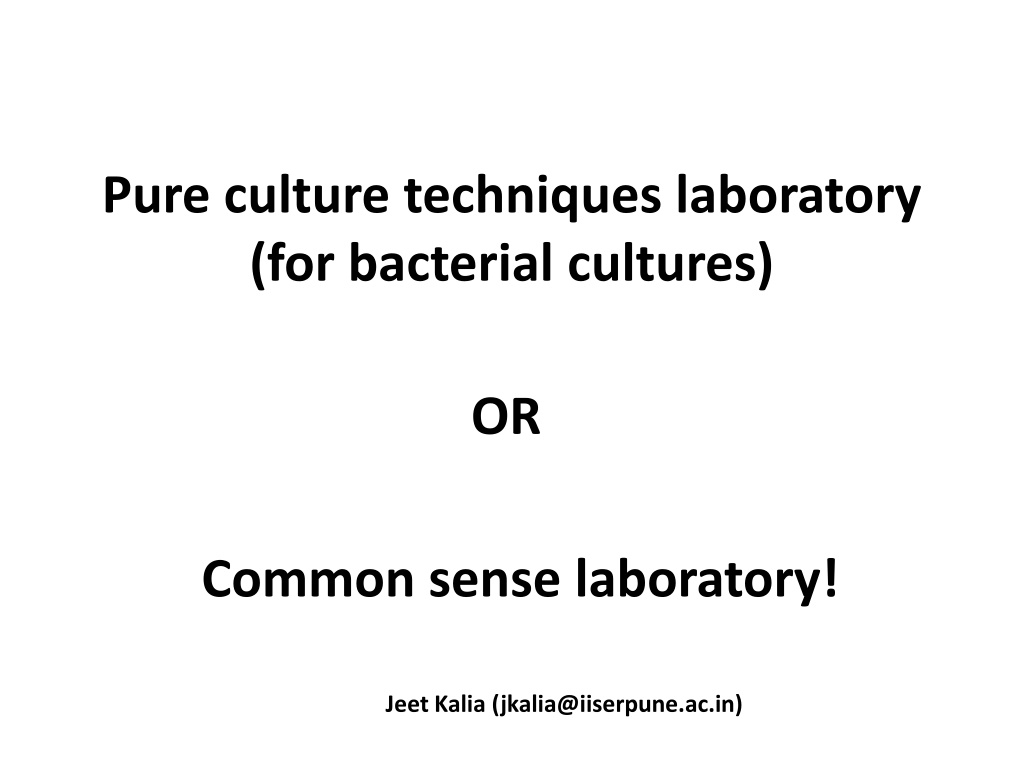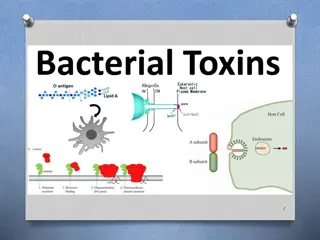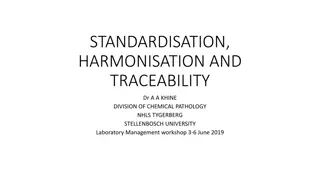Mastering Bacterial Culture Techniques in the Laboratory
Explore the fundamental steps and principles involved in culturing bacteria in a laboratory setting to achieve optimal growth. Understand the importance of providing essential nutrients, maintaining specific conditions, and following sterile protocols to prevent contamination. Enhance your knowledge of cultivating microorganisms for various research purposes and industrial applications.
Download Presentation

Please find below an Image/Link to download the presentation.
The content on the website is provided AS IS for your information and personal use only. It may not be sold, licensed, or shared on other websites without obtaining consent from the author. Download presentation by click this link. If you encounter any issues during the download, it is possible that the publisher has removed the file from their server.
E N D
Presentation Transcript
Pure culture techniques laboratory (for bacterial cultures) OR Common sense laboratory! Jeet Kalia (jkalia@iiserpune.ac.in)
The aim To grow microorganism of choice in the laboratory
Why grow organisms in the lab when they are present in nature? Large quantity needed for detailed studies To generate strains of interest Recombinant protein expression Industrial applications
Common sense begins! To culture microorganism in lab give them food! Nutrients: 1) Macronutrients (C, H, O, N, P, S, K+, Ca2+) 2) Micronutrients (Zn2+, Mn2+)
Nutrients must be supplied in the correct form Some molecules are unable to enter cells Some molecules can enter the cells but the enzymes for metabolizing them might not be present in the microorganism Not all microorganisms can use the same molecule as nutrition. These differences are used for identification of the microorganism. 5
Some bacteria are better synthetic chemists than others! Some bacteria can make all the organic compounds needed from a single carbon source such as glucose. Others need to be fed vitamins, amino acids, blood, etc. (needs to be added to the culture medium).
In addition to food, bacteria need other things to grow Temperature pH Osmolarity Before starting on trying to grow your microorganism: Know what nutrition and conditions it needs (read, read, read!)
General protocol for growing (or culturing ) bacteria Pouring media plates Streaking bacteria on media plates Picking a colony from the plate Inoculating a liquid culture Everything needs to be done under sterile conditions!!
Sterile conditions Why? To prevent contamination of your bacterial sample from environmental microorganisms Absolutely critical when working with pathogenic microorganisms
Sterile conditions How? 1) Autoclave the media (heat to 121 C and 20 psi)
Sterile conditions How? 2) Use sterile petri dishes, pipette tips, plastic tubes in a laminar hood sprayed with ethanol
Sterile conditions How? 3) Use common sense! Use gloves at all times Don t eat/touch other things/attend to your cell phones while handling bacterial cultures
General protocol for growing (or culturing ) bacteria Pouring media plates Streaking bacteria on media plates Picking a colony from the plate Inoculating a liquid culture
Pouring plates Autoclaved media (nutrients + agar) is poured on petri dishes. Agar is a matrix that solidifies on cooling.
Pouring plates Freshly poured After cooling
Examples of types of media LB (Lysogeny Broth/Luria Bertani) Agar 1) Agar 2) Tryptone 3) Yeast extract 4) NaCl MacConkey Agar (selective media for growing gram negative bacteria) 1) Agar 2) Enzymatic digest of gelatin, casein and animal tissue 3) NaCl 4) Bile salts and crystal violet: to inhibit Gram positive organisms. 5) Neutral Red: pH indicator (red in color at pH below 6.8) 6) Lactose Lactose utilizing bacteria: Pink colonies Bacteria that do not utilize lactose: White colonies
General protocol for growing (or culturing ) bacteria Pouring media plates Streaking bacteria on media plates Picking a colony from the plate Inoculating a liquid culture
Streaking bacteria on media plates Streaking loop Colonies (various sizes, shapes, colours)
General protocol for growing (or culturing ) bacteria Pouring media plates Streaking bacteria on media plates Picking a colony from the plate Inoculating a liquid culture
Picking a colony and inoculating liquid culture Put the picked colony in liquid media to grow bacteria Picking a colony
General protocol for growing (or culturing ) bacteria Pouring media plates Streaking bacteria on media plates Picking a colony from the plate Inoculating a liquid culture
Todays agenda Demonstration: Streaking plates Experiment: Streaking plates Observation: Observe different types of colonies and take notes (shape, size, colour) Midsem Viva: Good luck!























